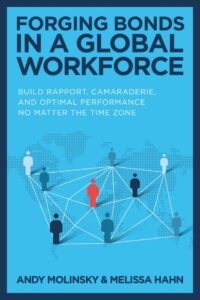An Interview with Andy Molinsky
The ability to lead a diverse and global team is not just a skill—it’s a necessity. Imagine a bridge spanning across vast oceans, linking continents together. This bridge is not made of steel or concrete, but of understanding, respect, and collaboration. It’s on this bridge that Andy Molinsky, a renowned expert in cross-cultural communication and author of the groundbreaking book Forging Bonds in a Global Workforce meets us.
The journey to effective global leadership is full of challenges. Language barriers, cultural misunderstandings, and the intricacies of remote communication are but a few hurdles we all face. Yet, Andy shares ways to overcome the obstacles. With the right mindset and tools, leaders can transform these challenges into opportunities.
In this interview, we dive deep into Andy’s latest book, seeking to uncover the strategies and principles that can help leaders forge stronger bonds within their global teams. From the power of empathy to the importance of cultural sensitivity, Andy shares his wealth of knowledge, offering practical advice and real-world examples to illuminate the path forward.
Andy, what inspired you to write Forging Bonds in a Global Workforce and how does it build upon your previous work?
I’ve always said that companies don’t go global; people do. For companies to leverage the tremendous opportunity of a global economy, they need to make sure that the people working on their behalf are effective at connecting and building relationships across cultures. With this in mind, you’d think that there would be lots of books focusing on building relationships across cultures – but surprisingly, there aren’t! And that’s what motivated my coauthor Melissa Hahn and I to write one. In terms of your question about my previous work: I’ve been researching global work for over 20 years as a Professor of International Management at Brandeis University, and I also wrote the book Global Dexterity in 2013 – about adapting behavior across cultures. So this new book was a natural next step for me!
Could you outline the key principles you believe are essential for building rapport and camaraderie in a global team?
 My co-author Melissa and I like to think about building rapport and camaraderie on a global team though the metaphor of a garden. With this metaphor in mind, there are two main ways to increase the odds of cultivating a flourishing garden. The first is by avoiding the “bad stuff” that makes a garden fail. This might include things like planting in bad sunlight, choosing the wrong plants for your soil, or failing to create a barrier between your plants and weeds. In the case of a global team, “avoiding the bad stuff” means limiting misperception and miscommunication that can easily result from cultural misunderstanding. To make a garden – or a global team – thrive, you also need an additional set of positive practices – the “good stuff.” With a garden, you need to water your plants and feed them compost and fertilizer. And with a global team, you need to work very hard to create opportunities for people to get to know each other, connect, and discover similar interests.
My co-author Melissa and I like to think about building rapport and camaraderie on a global team though the metaphor of a garden. With this metaphor in mind, there are two main ways to increase the odds of cultivating a flourishing garden. The first is by avoiding the “bad stuff” that makes a garden fail. This might include things like planting in bad sunlight, choosing the wrong plants for your soil, or failing to create a barrier between your plants and weeds. In the case of a global team, “avoiding the bad stuff” means limiting misperception and miscommunication that can easily result from cultural misunderstanding. To make a garden – or a global team – thrive, you also need an additional set of positive practices – the “good stuff.” With a garden, you need to water your plants and feed them compost and fertilizer. And with a global team, you need to work very hard to create opportunities for people to get to know each other, connect, and discover similar interests.
In your research, what have you identified as the most significant challenges leaders face when trying to forge bonds in culturally diverse teams?
Life on a global team can lack equity, especially for employees distant from headquarters who may struggle to access team leaders, resulting in their concerns being overlooked. Peripheral team members often face language and communication barriers, having to adapt to unfamiliar styles that may lead to their points being disregarded, impacting decision-making negatively. Logistically, remote team members must adjust their schedules to accommodate core members, often leading to inconvenient work hours. These challenges can leave remote members feeling underutilized, disconnected, disrespected, and isolated, with limited avenues for addressing these issues, ultimately affecting the team’s overall performance.
Can you share a couple of practical strategies from your book that leaders can implement to overcome these challenges?
Sure – there are many things you can do. You can – and should – ensure equitable distribution of burden in terms of distance, time, and convenience among team members by rotating the timing of calls or accommodating the schedules of the most remote employees. You can implement small gestures such as noting meeting times in multiple time zones to make remote members feel acknowledged. You should organize off-site meetings periodically in different locations to foster connection and collaboration, incorporating both business and bonding activities. You can integrate personal check-ins and video communication into virtual interactions to maintain engagement, especially for remote members. Finally, you should establish communication norms that encourage participation, considering cultural differences in communication styles. There are more strategies, but these are a few.
How important is cultural sensitivity in today’s global workforce, and how can leaders develop this trait according to your findings?
In my view, cultural sensitivity has never been more important. The problem is that most books only go halfway towards solving the problem because they focus on cultural differences alone – not on the skills and strategies for actually building connection. That’s where our book and research fit in: helping people not only understand cultural differences, but build connections and relationships in spite of – or even sometimes because of – cultural differences.
How does building rapport and camaraderie in a team translate to improved performance and productivity, based on your observations?
It all comes down to trust. To build effective relationships, you need to have three key qualities: you need to be seen as respectful, relatable, and reliable. When these key qualities are present, communication and collaboration improve, and the team itself is naturally more successful.
I particularly enjoyed message 3: I value the relationship. Talk a little more about this and its importance.
This was in a section of the book about managing conflict across cultures. Our findings suggest that it’s critical to send three key messages in the midst of a conflict: I value you; I value the relationship; and I value myself. They way you communicate these messages varies, but the key is to do it in as effective and authentic a way possible.
What do people get wrong about building relationships across cultures?
So many things! I like to think about this question from the standpoint of “myths” and “realities.” With this in mind, here are a few:
Myth #1: The country a person comes from is the main driver of their values, behaviors, and beliefs.
Reality: Many factors beyond national culture influence a person’s values, behaviors, and beliefs. People are influenced by their cultural background but are also able to creatively adapt and adjust their behavior in a new culture.
Myth #2: Building relationships in a foreign culture is mainly about avoiding mistakes.
Reality: Building relationships in another culture is about building a sense of trust and rapport so that mistakes don’t matter as much (and can even be learning opportunities).
Myth #3: The greatest barrier to relationship building across cultures is saying or doing the wrong thing.
Reality: The greatest barrier to relationship building across cultures is failing to find and focus on areas of commonality and connection
Myth #4: You have to really do your homework and master the dos and don’ts before trying to build relationships with people from another culture.
Reality: You aren’t working with a “culture” — you’re working with a specific person — who may — or may not — be characteristic of your predictions or expectations. So do your homework, but also assume your homework could be wrong.
Looking ahead, how do you see the dynamics of global workforces evolving, and what advice do you have for leaders to stay ahead?
While technological advances and AI are at the forefront of many businesses, it’s crucial not to overlook the human aspect of technological innovation. Products don’t market themselves; R&D doesn’t occur in a vacuum; and strategy isn’t executed solely by algorithms. People are behind the execution of every successful technological endeavor – and in most cases today, people from varied cultural backgrounds working together to bring innovation to fruition. That’s why this topic is so compelling and timely.
Any final words of advice about building relationships across cultures?
Yes, it’s not rocket science, but there are some key principles and strategies to learn. The ultimate goal is to eliminate the “bad stuff” – those distorted ways of thinking that can interfere with relationship building – while simultaneously introducing “the good stuff” – those key opportunities to build connection, discover similarities, and forge global bonds.
For more information, see Forging Bonds in a Global Workforce.
Image Credit: NASA.

